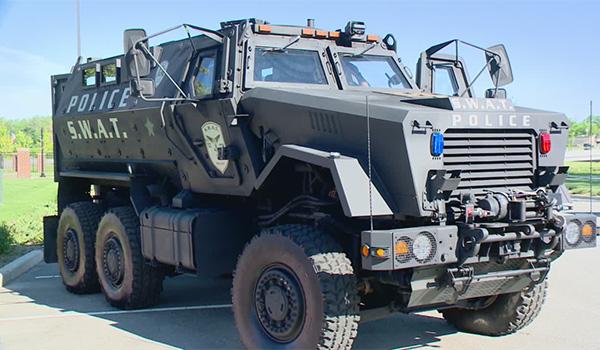Little Towns, Big (Government) Guns
The events in Ferguson, MO have drawn widespread public attention to the increasing militarization of local police departments. It’s a topic that has been discussed amongst civil–rights minded folks for the last decade or so and has both national and local impact. For instance, Glenn Reynolds wrote in 2006:
The trend toward militarizing police began in the ’60s and ’70s when standoffs with the Black Panthers, the Symbionese Liberation Army, and the University of Texas bell tower gunman Charles Whitman convinced many police departments that they needed more than .38 specials to deal with unusual, high-intensity threats. In 1965 Los Angeles inspector Daryl Gates, who later became police chief, signed off on the formation of a specially trained and equipped unit that he wanted to call the Special Weapons Attack Team. (The name was changed to the more palatable Special Weapons and Tactics). SWAT programs soon expanded beyond big cities with gang problems.
Abetting this trend was the federal government’s willingness to make surplus military equipment available to police and sheriffs’ departments. All sorts of hardware is available, from M-16s to body armor to armored personnel carriers and even helicopters. Lots of police departments grabbed the gear and started SWAT teams, even if they had no real need for them. The materiel was free, and it was fun. I don’t blame the police. Heck, if somebody gave me a Bradley Fighting Vehicle to play with, I’d probably start a SWAT team, too—so long as I didn’t have to foot the maintenance bill.
Thus, the sheriff’s department in landlocked Boone County, Ind., has an amphibious armored personnel carrier. (According to that county’s sheriff-elect, the vehicle has been used to deliver prescriptions to snow-bound elderly residents, and to provide protection during a suspected hostage situation.) Jasper, Fla.,—with 2000 inhabitants and two murders in the past 12 years—obtained seven M-16s from the federal government, leading an area newspaper to run a story with the subhead, “Three stoplights, seven M-16s.”
This approach, though, has led to problems both obvious and subtle. The obvious problem should be especially apparent to readers of this magazine: Once you’ve got a cool tool, you kind of want to use it. That’s true whether it’s a pneumatic drill, a laser level or an armored fighting vehicle. SWAT teams, designed to deal with rare events, wound up doing routine police work, like serving drug warrants.
The subtle effect is also real: Dress like a soldier and you think you’re at war. And, in wartime, civil liberties–or possible innocence–of the people on “the other side” don’t come up much. But the police aren’t at war with the citizens they serve, or at least they’re not supposed to be.
National Review’s Charles C.W. Cooke had a less-than-flattering take on what has been going on with the militarization of police departments: Barney Fife Meets Delta Force. Barney’s one and only bullet has been replaced by a MRAP.
A New York Times piece from June included a graphic illustrating the dispersion of military equipment amongst local police forces.
Further, a couple videos seem to prove Reynolds point about police departments using “cool tools”. The first comes via Jesse Walker who found this video on the Doraville, Georgia (population 8,500) police department website.
The second comes via Radley Balko who contrasts the pleasant police-recruitment video of Decatur, Georgia with that of Newport Beach, CA.
It has happened in Rhode Island, too. As the ProJo reported in December of 2012 (h/t), the town of Johnston’s (pop. 30,000) SWAT team has been building up:
The town of Johnston has received more than $4.1 million in military equipment over the past two years through a U.S. military surplus program that has supplied its Police Department with 30 M-16 rifles, 12 humvees, and military night-vision equipment, among others tools.
Supporters of the $2.5-billion surplus program see many valuable uses for municipal police departments. Johnston Police Detective Raymond Peters says the program is helping equip a SWAT team capable of becoming a “world-class hostage rescue team.”
Does Johnston need a SWAT team, much less a “world-class hostage rescue team”? When was the last hostage situation in Johnston, anyway?
This is not to say that SWAT team’s are unnecessary: they are needed. The Rhode Island State Police should certainly have one as should major cities like Providence and possibly “cities” like Warwick or Cranston. But does Johnston or Charlestown, which has a “part-time multi-jurisdictional SWAT Team”, need them? Part of the ramp up has been because we live in a post-9/11 world, and partly because the military is giving stuff away. But even with the “free stuff” there are costs. Tax-dollars are spent in equipment and training that could be spent better elsewhere (um, wait, this is Rhode Island, define “better”). But most importantly, there are social costs when it appears local police forces are more ready to take on the public than it is to protect and serve them.


